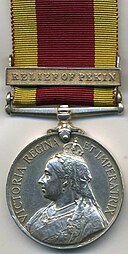Description
The obverse shows a crowned and veiled effigy of Queen Victoria, facing left, with the legend "VICTORIA REGINA ET IMPERATRIX" around the upper perimeter. [3]
The reverse shows the same shield bearing the Royal Arms, with a palm tree and trophy of arms behind and the inscription ‘ARMIS EXPOSCERE PACIM’ above, as found on the First and Second China War Medals. ‘CHINA 1900’ appears in the exergue below. [3]
The design was similar to the China War Medal given for the campaigns in 1842 and 1850s, with the reverse identical except the year, and the effigy of Queen Victoria on the obverse changed from the original by William Wyon, to one showing an older Queen, created by George William de Saulles for the Queen's South Africa Medal, and the word et Imperatrix added. [4]
The recipient's name and details were either impressed or engraved on the edge of the medal. [5]
The 1.25 inches (32 mm) ribbon is crimson with wide yellow edges.
Clasps
It could be issued without a clasp, or with one or more of the following clasps: [5]
Awarded to Royal Naval personnel of the British contingent of the international fleet involved in the attack of the Taku Forts along the Peiho River on 17 June 1900.
A total of 132 were awarded, to Royal Marines, the British Legation Guard drawn from several regiments and to civilian volunteers, who aided the defence of the Legation Quarter in Peking for 55 days between 20 June and 14 August 1900. [5]
Awarded to British and Indian army personnel and to men of the Royal Navy involved in the relief of the Legations in Peking between 10 June and 14 August 1900, as part of the international relief force (see Gaselee Expedition) or as part of Vice-Admiral Edward Seymour's Naval Brigade (see Seymour Expedition). [3]
The medal was awarded to 555 naval personnel of the Colonial navies of Australia without a clasp: 256 men with the New South Wales Contingent, 197 with the Victorian, and 102 on the South Australian gunboat Protector. [6]
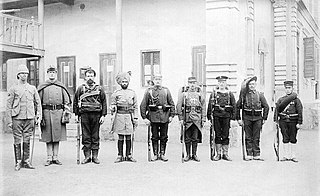
The China Relief Expedition was an expedition in China undertaken by the United States Armed Forces to rescue United States citizens, European nationals, and other foreign nationals during the latter years of the Boxer Rebellion, which lasted from 1898 to 1901. The China Relief Expedition was part of a multi-national military effort known as the Eight-Nation Alliance to which the United States contributed troops between 1900 and 1901. Towards the close of the expedition, the focus shifted from rescuing non-combatants to suppressing the rebellion. By 1902, at least in the city of Peking, the Boxer Rebellion had been effectively controlled.
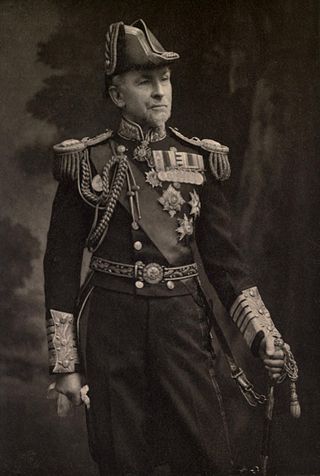
Admiral of the Fleet Sir Edward Hobart Seymour, was a Royal Navy officer. As a junior officer he served in the Black Sea during the Crimean War. He then took part in the sinking of the war-junks, the Battle of Canton and the Battle of Taku Forts during the Second Opium War and then saw action again at the Battle of Cixi during the Taiping Rebellion.

The Eight-Nation Alliance was a multinational military coalition that invaded northern China in 1900 with the stated aim of relieving the foreign legations in Beijing, then besieged by the popular Boxer militia, who were determined to remove foreign imperialism in China. The Allied forces consisted of about 45,000 troops from the eight nations of Germany, Japan, Russia, Britain, France, the United States, Italy, and Austria-Hungary. Neither the Chinese nor the quasi-concerted foreign allies issued a formal declaration of war.

The Crimea Medal was a campaign medal approved on 15 December 1854, for issue to officers and men of British units which fought in the Crimean War of 1854–56 against Russia. The medal was awarded with the British version of the Turkish Crimea Medal, but when a consignment of these was lost at sea, some troops received the Sardinian version.

The Queen's South Africa Medal is a British campaign medal awarded to British and Colonial military personnel, and to civilians employed in an official capacity, who served in the Second Boer War in South Africa. Altogether twenty-six clasps were awarded, to indicate participation in particular actions and campaigns.

The Meritorious Service Medal (MSM) is a British medal awarded to sergeants and warrant officers of the British armed forces for long and meritorious service. From 1916 to 1928, eligibility was extended to cover both valuable services by selected other ranks irrespective of length of service, and for gallantry not in the face of the enemy.
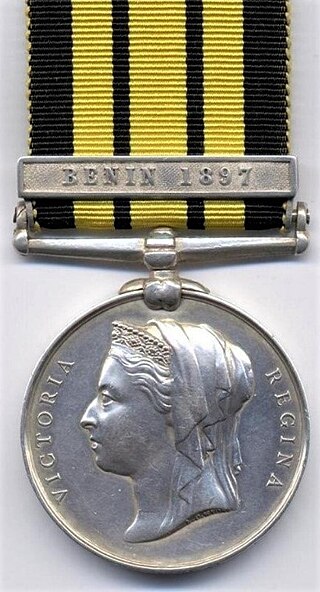
The East and West Africa Medal, established in 1892, was a campaign medal awarded for minor campaigns that took place in East and West Africa between 1887 and 1900. A total of twenty one clasps were issued.

The Afghanistan Medal, sanctioned on 19 March 1881, was awarded to members of the British and Indian armies who served in Afghanistan between 1878 and 1880 during the Second Afghan War, the first war being from 1839 to 1842.
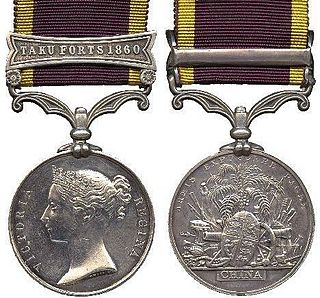
The Second China War Medal was issued by the British Government in 1861 to members of the British and Indian armies and Royal Navy who took part in the Second Opium War of 1857 to 1860 against China. The medal was designed by William Wyon.

The Efficiency Medal was instituted in 1930 for award to part-time warrant officers, non-commissioned officers and men after twelve years of efficient service on the active list of the Citizen Force of the Union of South Africa. At the same time, a clasp was instituted for award to holders of the medal upon completion of further periods of six years of efficient service. The medal superseded the Colonial Auxiliary Forces Long Service Medal.

The 1901 China expedition commemorative medal was a French military campaign medal established by the law of 15 April 1902 to recognize service in China in 1900 and 1901 during the Boxer Rebellion.

The Egypt Medal (1882–1889) was awarded for the military actions involving the British Army and Royal Navy during the 1882 Anglo-Egyptian War and in the Sudan between 1884 and 1889.

The Diamond Jubilee Medal was instituted in 1897 by Royal Warrant as a British decoration. The medal was awarded to members of the Royal Family and the court, guests and dignitaries present at the celebrations of Queen Victoria's diamond jubilee and to selected soldiers and sailors who formed the jubilee parade in London.

The Golden Jubilee Medal was instituted in 1887 by Royal Warrant as a British decoration to be awarded to participants of Queen Victoria's golden jubilee celebrations.

The Royal Naval Volunteer Reserve Long Service and Good Conduct Medal, initially designated the Royal Naval Volunteer Reserve Long Service Medal, was instituted in 1908. It could be awarded to part-time ratings in the United Kingdom's Royal Naval Volunteer Reserve after twelve years of service and good conduct. The medal was a Naval version of the Volunteer Long Service Medal and its successor, the Territorial Force Efficiency Medal.

The Central Africa Medal was a British campaign medal awarded for service from 1891–1894 in Eastern and Central Africa, and from 1894–1898 for service in British Central Africa.

The Naval Long Service and Good Conduct Medal (1848) is a long service medal awarded to regular members of His Majesty's Naval Service. It was instituted by Queen Victoria to replace the Naval Long Service and Good Conduct Medal (1830), and could be awarded to other ranks and men serving in the Royal Navy and Royal Marines. Since 2016, after a number of changes in eligibility, all regular members of the Royal Navy and Royal Marines who have completed fifteen years of reckonable service can be awarded the medal.

The Naval Good Shooting Medal is a Naval gunnery medal that was instituted in 1902, for award to the gunner on each type of ship's gun in the fleet who achieved first place in the gunnery competitions held during the Annual Fleet Competitions. From 1903 to 1914 medals were awarded annually, until the competition was discontinued upon the outbreak of the First World War.

The Volunteer Long Service Medal was instituted in 1894 as an award for long service by other ranks and some officers of the United Kingdom's Volunteer Force. In 1896, the grant of the medal was extended to other ranks and officers who had served in the ranks of the Volunteer Forces throughout the British Empire. A separate new medal was instituted, the Volunteer Long Service Medal for India and the Colonies. Awarding of this medal was discontinued in stages when it was superseded in most territories by the Colonial Auxiliary Forces Long Service Medal in 1899 and in the remainder by the Efficiency Medal in 1930.

The Medal for the Best Shot in the British Army, Infantry, was instituted by Queen Victoria in 1869 and was awarded annually from 1870 to 1882 to the best shot of the Infantry of the British Army, including the Royal Engineers and the Colonial Corps.
